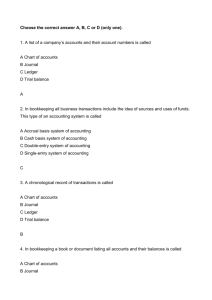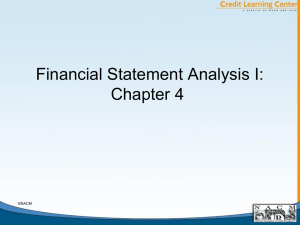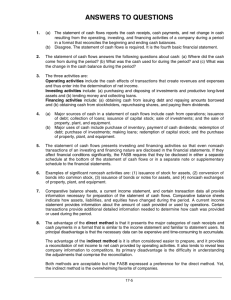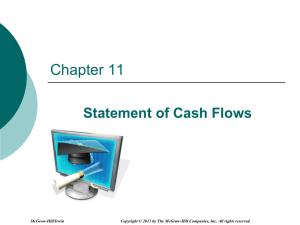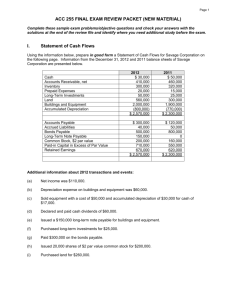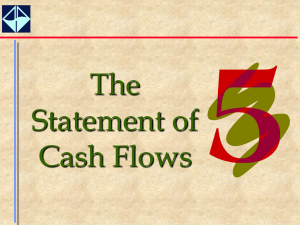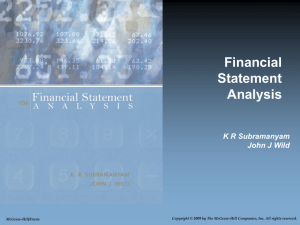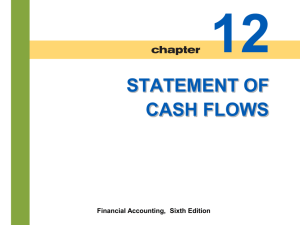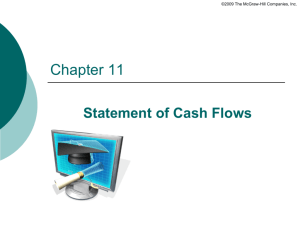chapter_12_quiz-_fin_acct
advertisement
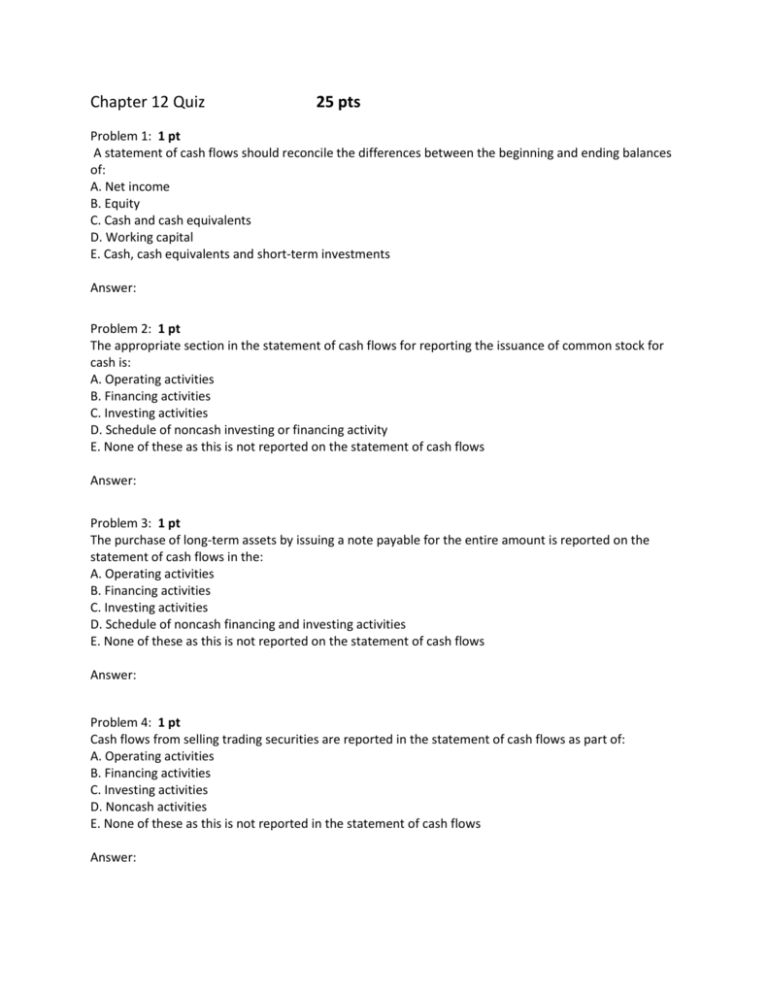
Chapter 12 Quiz 25 pts Problem 1: 1 pt A statement of cash flows should reconcile the differences between the beginning and ending balances of: A. Net income B. Equity C. Cash and cash equivalents D. Working capital E. Cash, cash equivalents and short-term investments Answer: Problem 2: 1 pt The appropriate section in the statement of cash flows for reporting the issuance of common stock for cash is: A. Operating activities B. Financing activities C. Investing activities D. Schedule of noncash investing or financing activity E. None of these as this is not reported on the statement of cash flows Answer: Problem 3: 1 pt The purchase of long-term assets by issuing a note payable for the entire amount is reported on the statement of cash flows in the: A. Operating activities B. Financing activities C. Investing activities D. Schedule of noncash financing and investing activities E. None of these as this is not reported on the statement of cash flows Answer: Problem 4: 1 pt Cash flows from selling trading securities are reported in the statement of cash flows as part of: A. Operating activities B. Financing activities C. Investing activities D. Noncash activities E. None of these as this is not reported in the statement of cash flows Answer: Problem 5: 1 pt A company's transactions with its creditors to borrow money and/or to repay the principal amounts of loans are reported as cash flows from: A. Operating activities B. Investing activities C. Financing activities D. Direct activities E. Indirect activities Answer: Problem 6: 1 pt The accounting principle that requires significant noncash financing and investing activities be reported on the statement of cash flows is the: A. Historical cost principle B. Materiality principle C. Full disclosure principle D. Going concern principle E. Business entity principle Answer: Problem 7: 1 pt The cash flow on total assets ratio: A. Is the same as return on assets B. Is the same as profit margin C. Can be an indicator of earnings quality D. Is highly affected by accounting principles of income recognition and measurement E. Is average net assets divided by cash flows from operations Answer: Problem 8: 3 pts Use the following information and the indirect method to calculate the net cash provided or used by operating activities: Net income Depreciation expense Payment on mortgage payable Gain on sale of land Increase in merchandise inventory Increase in accounts payable Proceeds from sale of land $12,300 12,000 15,000 7,500 2,050 6,150 8,000 A. $12,700 B. $13,900 C. $20,900 D. $28,400 E. $35,900 Answer: Problem 9: 5 pts Use the cash flow on total assets ratio to determine which of these three companies is using its assets most efficiently. 5 pts Cash provided by operations Cash provided (used) by investing activities Purchase of operating assets Cash provided (used) by financing activities Repayment of debt Net Increase in cash Average total assets Company A $ 300,000 Company B $ 600,000 Company C $ 400,000 (190,000) (380,000) (200,000) (100,000) (210,000) (190,000) $ 10,000 $ 2,500,000 $ 10,000 $ 6,000,000 $ 10,000 $ 5,000,000 Show your work: A. Company A B. Company B C. Company C D. As all the companies have the same net increase in cash, they are all equally efficient in the use of their assets E. Cannot be determined from the given information Answer: Problem 10: 10 Pts The following information is available for the Arthur Corporation: Arthur Corporation Balance Sheets At December 31 Assets: Cash Accounts receivable Merchandise inventory Long-term investments Equipment 2010 2009 $ 24,640 32,180 73,125 55,900 175,500 $ 23,040 29,400 61,710 56,400 145,500 Accumulated depreciation Total assets Liabilities: Accounts payable Income taxes payable Bonds payable Total liabilities Equity: Common stock Contributed capital in excess of par Retained earnings Total equity Total liabilities and equity Arthur Corporation Income Statement For Year Ended December 31, 2010 Sales Cost of goods sold Depreciation expense Other operating expenses Interest expense Other gains (losses): Loss on sale of equipment Income before taxes Income taxes expense Net income (33,550) $327,795 (31,200) $284,850 $ 65,000 10,725 48,750 $124,475 $40,380 10,200 66,000 $116,580 117,000 13,000 73,320 $203,320 $327,795 96,000 9,000 63,270 $168,270 $284,850 $240,000 $80,900 29,400 48,000 2,000 (160,300) (8,400) 71,300 (27,650) $ 43,650 Additional Information: (1) There was no gain or loss on the sales of the long-term investments, nor on the bonds retired. (2) Old equipment with an original cost of $37,550 was sold for $2,100 cash. (3) New equipment was purchased for $67,550 cash. (4) Cash dividends of $33,600 were paid. (5) Additional shares of stock were issued for cash. Prepare a complete statement of cash flows for the 2009 calendar year using the direct method. Answer: (a) Cash receipts from customers: (b) Cash paid for merchandise inventory: (c) Payments for income taxes: (d) Received from sales of long-term investments: (e) Received from stock issuance: (f) Paid to retire bonds: Arthur Corp. Statement of Cash Flows (direct method) For Year Ended December 31, 2010 Cash flows from operating activities: (a) (b) given (c) given Cash flows from investing activities (d) given given Cash flows from financing activities: (e) (f) given Net in cash Cash balance beginning of year Cash balance end of year ``


